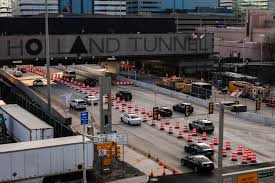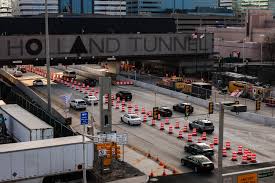Most drivers passing under the new tolling gantries will be charged a once-per-day toll to enter Manhattan’s Congestion Relief Zone south of 60th Street. The system is set up to charge most drivers $9 during peak hours between 5 a.m. and 9 p.m. on weekdays and from 9 a.m. to 9 p.m. on weekends. The toll costs $2.25 overnight.
Drivers taking the Holland or Lincoln tunnels will get a $3 rebate during peak hours only. Taxi riders will pay a new 75-cent surcharge, but it’s double if you take Uber or Lyft. Trucks are paying the most, with the largest having to dish out $21.60 at peak.
Sunday’s rollout was the first big test, and MTA officials said there were no major issues. The money generated is expected to help fund the city’s public transit system and help pay for things like new subway cars, buses and large-scale projects like the Second Avenue Subway.
Drivers should check the status of their E-ZPass accounts to make sure they’re in good standing and up to date. If drivers opt to pay by mail, they will be charged $13.50, instead of $9.
New Jersey drivers hit with congestion pricing and higher tolls
Monday’s commute is a double-whammy for New Jersey drivers. Not only are the congestion pricing tolls in effect, but the Port Authority of New York and New Jersey also, coincidentally, chose this past weekend to hike the price of its bridges and tunnels by 3 percent. That means a peak trip into the city will now cost $22.06 – a whopping $6.68 more than before.
New Jersey officials tried until the last minute to fight off congestion pricing, citing environmental concerns, but to no avail. On Friday, a federal judge denied the Garden State’s request for a temporary restraining order. Attorneys have vowed to appeal, but the tolling has already begun.
Congestion pricing is highly unpopular in New Jersey, where many suburban drivers feel they are being punished due to MTA mismanagement.
The one reprieve New Jersey drivers do get is if they use the Lincoln or Holland tunnels, they will receive a $3 toll credit. But those using the George Washington Bridge will not receive a discount.
Will more Long Island commuters ride the rails?
One big question is whether more Long Island commuters will be parking their cars and taking the train into the city.
There are some perks for commuters who choose to take public transit now that congestion pricing has begun.
This weekend was the start of a new initiative where monthly LIRR and Metro-North tickets will be honored at all stations, regardless of what’s printed on the ticket. Saturday was also the start of the MTA’s winter weekend discount program, which means monthly ticketholders can bring up to two guests on board with them for $1 each.
The MTA says, over time, customers can also expect to see improvements in their commute. About $1.5 billion of the revenue will be spent on capital improvements to the LIRR, including upgraded signals, repairs for platforms and stations, replacing outdated train cars and improving accessibility.
Subway riders split on congestion pricing impact
Congestion pricing has both vocal supporters and detractors, seemingly split on whether this will actually improve public transit.
“I heard the chairman of the MTA said the point is to try to get people to make use of the subway. I think it’s a great idea for real,” said Mohammedbasheer Tanimu, who recently moved to New York.
“There will be way more people on the trains now that congestion pricing is going up,” Washington Heights resident Thomas Velasquez said.
The MTA has said the goal is to improve mass transit with the money the first-in-the-nation toll brings in, while also getting people out of their cars in the process.
Watch live team coverage from our reporters across the region, as we hear from commuters about their experience.

